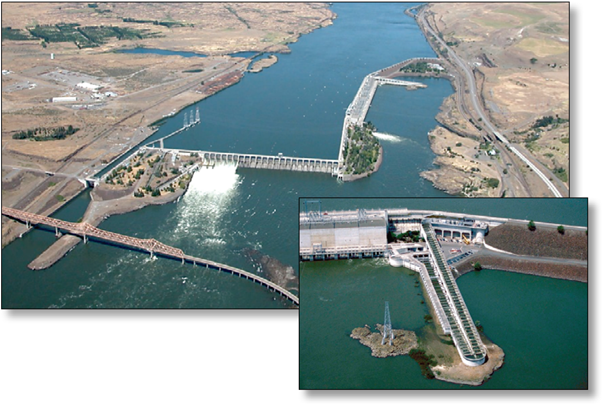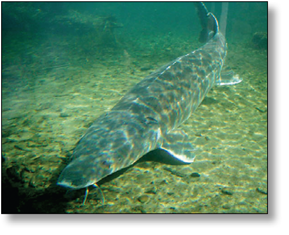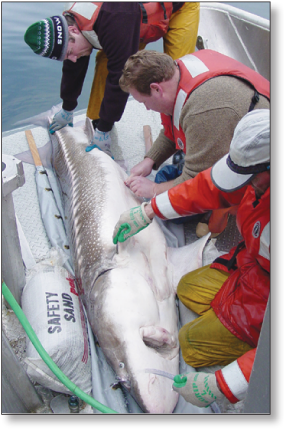Fact Sheet 2008–3081

Researchers at the USGS Western Fisheries Research Center’s Columbia River Research Laboratory, working with the U.S. Army Corps of Engineers, sought to better understand upstream and downstream passage of white sturgeon at dams. A study at The Dalles Dam provided the opportunity to compare two fish ladders; one that passes sturgeon upstream to one that does not, to determine if subtle differences in construction result in better passage of white sturgeon. Researchers conducted a study using a combination of acoustic and radio telemetry technologies to obtain information on juvenile and adult white sturgeon near The Dalles Dam, with the objectives of characterizing the distribution and movements of white sturgeon in the immediate vicinity of the dam and to determine timing and routes of upstream and downstream passage.
White sturgeon Acipenser transmontanus are the largest freshwater fish in North America, and they are an important cultural, recreational, and commercial resource in the Columbia River Basin. Prior to the building of dams for hydroelectric power production and other uses, this species likely responded to seasonal changes in food and habitat availability by ranging extensively between freshwater, estuarine, and marine environments. Construction of the dams has largely blocked upstream sturgeon movements, although downstream passage still occurs. An exception to this is the east fish ladder at The Dalles Dam where significant numbers of white sturgeon have been counted passing upstream.
 White sturgeon.
White sturgeon.Columbia River Basin hydroelectric dams provide many benefits to society including electricity, navigation, water for irrigation, and recreation. However, they also impede migrations of fish. White sturgeon seldom ascend fish ladders at dams probably because fish passage facilities for upstream migrating fish were designed primarily for adult salmon and steelhead. The large body size and swimming capabilities of white sturgeon were not considered during the design of the fish ladders. Past studies have shown that white sturgeon do pass downstream through the dams, but the routes of passage through dams were never identified. Downstream passage by fish is possible only through operating turbines, open spill gates, the ice and trash sluiceway when it is operating or the navigation lock as vessels pass up or down stream.
Upstream passage of white sturgeon does occur at some dams but the number of fish counted is typically quite low and at many ladders often no white sturgeon are counted. However, at The Dalles Dam, far greater numbers of white sturgeon are often seen. This dam has two fish ladders, and the east ladder nearly always allows a substantial number of white sturgeon to pass upstream. For example, in 1995 fish counters at the dam noted 943 white sturgeon passing upstream in the east fish ladder and 104 in the north fish ladder.
The researchers captured and tagged 148 white sturgeon ranging in size from 95 to 280 cm (37 to 110 in.) in length. Ninety fish were released downstream of the dam and 58 were released upstream.
 Map showing dam locations. |
 Lower reach of the north fish ladder. |
 USGS staff surgically implanting a transmitter in a large white sturgeon.
USGS staff surgically implanting a transmitter in a large white sturgeon.The researchers determined that some tagged white sturgeon entered and resided in both fish ladders, but only successfully passed upstream through the east ladder. They determined that although both ladders at this dam have overflow weirs with submerged orifices so fish can pass near the surface or along the bottom of the ladder, the east fish ladder is built slightly larger than the north fish ladder. In particular, the east ladder is wider by 1.82 m (6 ft) and the submerged orifices are twice the size of the orifices in the north ladder.
The researchers also determined that white sturgeon passed downstream through open spillway gates. The researchers unexpectedly discovered that some fish that passed downstream through the spillway gates quickly returned back upstream by passing through the east ladder. Also, some fish that were tagged passed downstream through the Bonneville Reservoir and Bonneville Dam and were subsequently located in the Columbia River estuary.
Fish smaller than those tagged in this study pass downstream as well. Trash-racks on the turbine intakes prevent large fish from passing downstream through turbines, but smaller fish could pass through the turbines as well as pass over the spillways when the gates are open.
Sturgeons as a group of about 25 species worldwide (the exact number depends on whether you count certain subspecies as one or two species), are considered to be among the world’s most endangered and threatened fishes. This research shows that fish ladders can be built to provide upstream passage for white sturgeon, and indicates that ladders can be built for other species as well. In the Columbia River Basin, further research is needed to understand how ongoing changes to operations at hydroelectric dams to benefit migrating salmonids may influence upstream or downstream passage by white sturgeon.
For more information, contact:
Michael J. Parsley
U.S. Geological Survey
Western Fisheries Research Center
Columbia River Research Laboratory
5501A Cook-Underwood Road,
Cook, WA 98605
(509) 538-2299 ext. 247
FAX (509) 538-2843
mparsley@usgs.gov
http://wfrc.usgs.gov
This report is available online in Portable Document Format (PDF). If you do not have the Adobe Reader, it is available for free download from Adobe Systems Incorporated.
Document Accessibility: Adobe Systems Incorporated has information about PDFs and the visually impaired. This information provides tools to help make PDF files accessible. These tools convert Adobe PDF documents into HTML or ASCII text, which then can be read by a number of common screen-reading programs that synthesize text as audible speech. In addition, an accessible version of Adobe Reader 8.0 for Windows (English only), which contains support for screen readers, is available. These tools and the accessible reader may be obtained free from Adobe at Adobe Access.